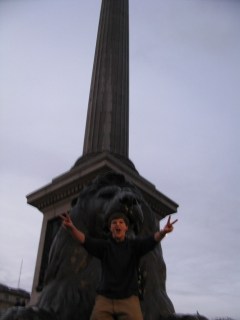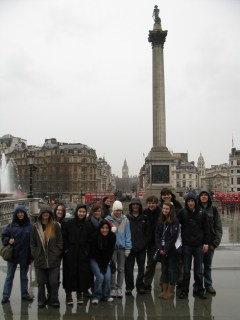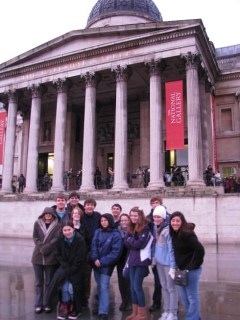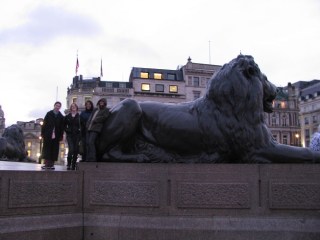 Day three in London was another busy day, with us leaving the hotel around 9:15 and getting back around 11:00. It involved less walking than on Wednesday, but involved a lot of standing. Plus, as we headed out, it was a “soft” day, as the Irish say: it was raining lightly. Still, we expected it to rain some, and it was a largely indoor kind of day, so that all worked out fine.
Day three in London was another busy day, with us leaving the hotel around 9:15 and getting back around 11:00. It involved less walking than on Wednesday, but involved a lot of standing. Plus, as we headed out, it was a “soft” day, as the Irish say: it was raining lightly. Still, we expected it to rain some, and it was a largely indoor kind of day, so that all worked out fine.
We did our first three-line Tube journey, where we changed from the DLR line to the District line to the Northern line, and that went well. We got off the Tube at Charing Cross station, and proceeded to get up to the street, right next to Trafalgar Square.
Trafalgar Square is a huge square that celebrates Admiral Lord Nelson’s naval victory at Trafalgar, and the square is very impressive. Despite the rain, the kids were game souls and let me take a picture of them in the square, in the rain. We then headed over to the National Gallery, London’s main art museum. I’m afraid I left everyone hanging for a while – I needed to pay for our tour bill, but it took about 25 minutes for me to take care of that. In retrospect, I wish I had let everyone go tour while I took care of that. Mistakes do happen on these tours. As it was, the kids had about 20 minutes to explore the museum or to look in the gift shop before our tour started.
We met up with our tour leader in the Education Centre of the museum, and she was great. She actually tried to get to know all of the kids’ names, and she largely succeeded. She took us into a room of the museum, and asked us the purpose of art. Oddly, our normally academic and outgoing students suddenly were shy. The were willing to answer questions when called on, but were a bit timid about answering on their own. It was a bit strange, since they are so gifted at, well, being smart. Anyway, our guide, Gayna, talked about how art shows us perceptions from a time in history, and can speak to us today through the similarities and differences. She also talked about how art can really make you see the world differently through heightening awareness of color, horizon, detail, and such. She told us that art was like music – some of it would resonate for us and some of it would not. It was a good introduction.
 Gayna then took us to see four paintings. I had asked for a tour about religion and art, and Gayna also found out that we had a few Latin scholars along, so she showed us three Christian paintings and one painting from Greek mythology. She showed us how perspective developed over time and how that changed the paintings, and she talked about symbolism and how the symbols changed depending on if a painting was Christian or not. For instance, we found out that saints are identified by objects they carry (St. Catherine carries a wheel because she died on a torture wheel), and that saints who were martyred often carry green feathers. We found out that a peacock in Christian paintings represents the all-seeing nature of God and that in mythological paintings it represents the queen of the gods, Hera (or Juno). It was a very interesting and informative tour, and spending one hour on four paintings may seem like a lot, but it did not feel slow at all.
Gayna then took us to see four paintings. I had asked for a tour about religion and art, and Gayna also found out that we had a few Latin scholars along, so she showed us three Christian paintings and one painting from Greek mythology. She showed us how perspective developed over time and how that changed the paintings, and she talked about symbolism and how the symbols changed depending on if a painting was Christian or not. For instance, we found out that saints are identified by objects they carry (St. Catherine carries a wheel because she died on a torture wheel), and that saints who were martyred often carry green feathers. We found out that a peacock in Christian paintings represents the all-seeing nature of God and that in mythological paintings it represents the queen of the gods, Hera (or Juno). It was a very interesting and informative tour, and spending one hour on four paintings may seem like a lot, but it did not feel slow at all.
After the tour finished at 12:00, we let the kids go for free time and lunch until 1:50, when our next tour would begin. I recommended checking out one of my favorite churches, St. Martin-in-the-Fields, and we informed them that they could eat in the cafeteria of St. Martin’s, which happens to be in the crypt. The kids who took us up on that reported that they liked the food and seeing the church, but there were a couple of cross-cultural moments that make travel fun: one student was surprised to be asked if he wanted mustard and applesauce on his ham sandwich, and another student slathered on a ton of mustard that turned out to contain a lot of something that was spicy. Mer and I went in to St. Martin’s and sat for awhile. I prayed a little, and also filled out an evaluation form for the National Gallery tour. It was very peaceful. Mer and I finished our lunchtime by spending about 45 minutes touring some of the greatest Renaissance paintings in the National Gallery. We were very pleased to find out later that many students had gone back in to the Gallery after they had eaten lunch.
 We met up with our Blue Badge tour guide, Deborah. Blue Badge guides are professional guides, and Deborah will end up being our guide for four different sights. Deborah started by showing us the National Portrait Gallery, which is made up of portraits (mostly paintings, with a few sculptures) of people who were important to Great Britain. Deborah took us to the very start of the paintings, the earliest kings, from the late 15th century. She then walked us through the not-always-easy-to-follow succession of the crown. The blur of names and dates was a lot for me, but helped Meredith solidify her knowledge of the crown, which she uses for her English literature sections of her classes. A few things I remember: King Henry the Eighth stayed with his first wife for 24 years before breaking away from the church in Rome so he could divorce her so he could try to have a son. Also, after Henry VIII it was not a very good idea to name you child Henry because he inevitably died before he could take the throne. And, Parliament kept ignoring the rules of royal succession in order to keep a Protestant monarch on the throne. Lastly, Elizabeth and Victoria reigned for such a long time they had eras named for them.
We met up with our Blue Badge tour guide, Deborah. Blue Badge guides are professional guides, and Deborah will end up being our guide for four different sights. Deborah started by showing us the National Portrait Gallery, which is made up of portraits (mostly paintings, with a few sculptures) of people who were important to Great Britain. Deborah took us to the very start of the paintings, the earliest kings, from the late 15th century. She then walked us through the not-always-easy-to-follow succession of the crown. The blur of names and dates was a lot for me, but helped Meredith solidify her knowledge of the crown, which she uses for her English literature sections of her classes. A few things I remember: King Henry the Eighth stayed with his first wife for 24 years before breaking away from the church in Rome so he could divorce her so he could try to have a son. Also, after Henry VIII it was not a very good idea to name you child Henry because he inevitably died before he could take the throne. And, Parliament kept ignoring the rules of royal succession in order to keep a Protestant monarch on the throne. Lastly, Elizabeth and Victoria reigned for such a long time they had eras named for them.
The tour lasted two hours, and it was very good. In the future, if we get to do this again, we may shorten the tour to 60 or 90 minutes so the kids can have time to explore. We said goodbye to Deborah for the time being, and we made our way outside, where, to our delight, it had stopped raining. Since it was not raining, we let the kids have 15 or 20 minutes to explore Trafalgar Square and to take pictures. They had a grand time doing that – lots of pictures and clambering about on the monuments for poses and better pictures and the like. It was a lot of fun, and I laughed a lot.
We then jumped back on the Tube to the Chalk House station, where we found the Roundhouse Theatre (with the unsolicited and welcome help of a friendly British man). We gave the kids an hour and a half to go get supper anywhere they liked, and Mer and I headed off with some students in tow to go find a pub I wanted to eat in. We found it, but the students could not find enough seats for all of them, so they left to try other places. Later we heard they found a restaurant that offered foods from all over the world and they liked it. I was pleased with the pub – it was full of locals, the bartender was very friendly and helpful, the food was good; the chips (French fries) were the best I have ever had, and when I ordered a Sprite, I was asked, “Half-pint or pint?” I was delighted to actually get to order a pint from an English pub. It made me smile.
 We all met back up at the Roundhouse Theatre on time. We were there to see a Royal Shakespeare Company production of Julius Caesar. It started at 7:15, and we all had good seats for the production, although we were in two groups, since they had not been able to seat fifteen people together. The theater had good sight-lines, with the stage being a thrust stage with seats on three sides.
We all met back up at the Roundhouse Theatre on time. We were there to see a Royal Shakespeare Company production of Julius Caesar. It started at 7:15, and we all had good seats for the production, although we were in two groups, since they had not been able to seat fifteen people together. The theater had good sight-lines, with the stage being a thrust stage with seats on three sides.
The stage was usually bare, with the scenery being set by projected computer images: a large image on a big screen, and images of vaguely-shaped people on smaller screens on the stage that represented the crowds of Rome or the armies later in the play.
The play was strongly acted. I loved the actor playing Caesar from the start, and although I was unsure of Brutus and Marc Antony at first, they quickly grew on me. Cassius, the major ally of Brutus, was also excellent, and he actually became quite a sympathetic character. Marc Antony’s speech to the crowds of Rome after Caesar’s death was magnificent to see in all of its subtle and not-so-subtle manipulation.
I struggled with the play a little at the first because I was so tired that I was having trouble staying awake. I finally woke up fully after taking off my outer shirts, but the initial drowsiness did create a bit of disconnect with the play for me that took a little time to get over. Once I caught back up, I enjoyed the play very much.
One of the very cool things they did in the play included starting the play off by sprinkling rose petals all over the stage. The text can call for this since one of the players talks about spreading flowers before Caesar, but it struck me as a bit odd, since it was all over the stage and left there for the entire play. It all made sense, though, when Caesar was killed – it then appeared as if the entire stage was coated in blood, and it looked the same for the battles later on in the play.
It is not always easy to follow Shakespeare, especially when you are pretty tired from being toured all over London by two half-crazed leaders. However, the kids seemed to track with the play and even had some thoughts on the staging they had seen, including informing me and Meredith that the play would have opened with the Feast of the Lupercal, which we had not known, but would have explained the wolf symbols used at the opening.
 We got back home efficiently thanks to a moment I was delighted in – two students suggested a way home that made better sense than what I had been thinking of. They were picking up on how to read the Tube map, and that was gratifying. We got home about 11:30, and let everyone know they could sleep in on Friday if they wished. I think we all wished for that.
We got back home efficiently thanks to a moment I was delighted in – two students suggested a way home that made better sense than what I had been thinking of. They were picking up on how to read the Tube map, and that was gratifying. We got home about 11:30, and let everyone know they could sleep in on Friday if they wished. I think we all wished for that.
These blogs are so detailed that I feel like I’m traveling with you. Thank you! -Janet